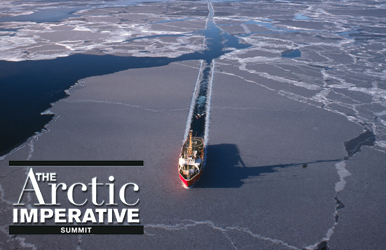Chasing Arctic dreams
 America’s last frontier stretches cold and desolate for more than 1,000 miles east from Canada before turning south along the Bering Sea within sight of Russia.
America’s last frontier stretches cold and desolate for more than 1,000 miles east from Canada before turning south along the Bering Sea within sight of Russia.
Here in the far north of the nation’s northernmost state is the only land to resist a nation-defining entrepreneurial spirit that for more than 100 years raged west into wilderness from a toehold on the Atlantic to the warm, sun-washed beaches of the Pacific now home to movie stars.
Three-hundred and fifty miles to the south in the modern comfort of Anchorage and Girdwood, the “Arctic Imperative Summit” convenes Friday evening through Monday to ruminate on what is to become of this frontier.
On the agenda for the meeting are financiers with money to invest in the north, political leaders with influence to make things happen, businessmen with high hopes in the high latitudes, and some Alaska Natives, not to mention environmentalists, who are a little nervous about the changing Arctic.
Alaska’s largest city has a lot more in common with the conquered land that is America south of the 49th parallel than with the Arctic, but Anchorage is where most conversations about the fate of the nation’s last primitive coast take place. Anchorage launched the last Arctic assault in the late 1960s and early 1970s, when American oil companies went after the crude buried beneath the ground near Prudhoe Bay. Today Prudhoe is a small blip — a moon station of sorts — on a horizon that quickly stretches away to nothing in all directions.
Some would like to keep it that way. Others are convinced the future of Alaska — and possibly of the nation — hinges on prying the natural riches out of this land. As the “Arctic Imperative” conclave of political and economic movers and shakers heads toward its second-annual gathering, it is as interesting to ponder what isn’t in the Arctic as much as what is.
Arctic Nation
Near the end of his second term, President George W. Bush in January 2009 officially declared “that the United States is an Arctic nation.” But it is hard to tell by looking.
There exists little of a U.S. presence north of the Arctic Circle. The Naval Arctic Research Lab, once a leader in Arctic research, left the top-of-the-world community of Barrow in 1980. The U.S. Coast Guard made a show of returning to the community this year.
“Coast Guard Forward Operating Location Barrow, Alaska became officially operational Monday,” proclaimed a Coast Guard press release July 20. The New York Times followed that up a day later with a report that underlined the sparse facilities for the Coast Guard’s temporary, summer air station (there was no port station because there is no port), while noting the operations “will presumably only expand.”
Presumptions have been the Arctic story for a long time now.
Alaskans, who live in a state near totally dependent on oil taxes to run government, presume Royal Dutch Shell will find significant qualities of oil offshore in the Chukchi Sea and begin moving toward production that would boost the flow in the trans-Alaska oil pipeline, if the company ever gets past the roadblocks thrown up by environmentalists. The U.S. government presumes that global warming will open now ice-choked waters and alter global shipping. And the handful of residents in the Arctic — something less than 30,000 in all — presume the future is sure to bring a change, for better or for worse.
Some look at Shell’s oil drilling plans and envision jobs, cash and the comforts of life that go along with those things. Others look at the same and see a threat to age-old whaling traditions. It is easy for those living in the Arctic to feel threatened. There is these days much talk of oil development, expanded shipping through the Bering Strait, and mining of untapped mineral resources, including possibly rare earth elements vital in the production of computers and other high-tech gadgetry. The state has been studying the feasibility of a road or railroad to one such mineral concentration in the Ambler Mining District of the Northwest Arctic.
Sometimes it actually sounds as if something might be happening, but it doesn’t look like it on the ground.
As with so much in the Alaska Arctic, it is easy to view new ideas for development as positive economic advances or just so much talk. There has always been a lot of talk. Until his 2010 death at age 90, former Alaska Gov. Wally Hickel dreamed of a railroad tunnel beneath the Bering Strait “linking the world’s greatest industrial nations with the vast, untapped mineral resources of the Arctic…. the continental United States, with the greatest economy on Earth….badly needs resources. Building a corridor, linked across the Bering Strait, will provide access to our Arctic resources of oil, gas, precious minerals of all kinds, and freshwater.”
That idea went exactly as far as the natural gas pipeline that another Alaska governor — Sarah Palin — told the 2008 Republican National Convention was under construction from the Arctic to the Lower 48. It wasn’t. Some 35 trillion cubic feet of proven natural gas reserves remain trapped in the ground on Alaska’s North Slope because of the lack of an economical way to move the gas to markets.
Activity in the North
The Arctic is a costly environment in which to operate. Private industry needs the promise of big profits — as was the case with developing the Prudhoe Bay oil field, the nation’s largest — to encourage it to take the big risks. Government needs the incentives of politics. Cold War struggles between the U.S. and the former Soviet Union helped drive the research at the Naval Arctic Research in Barrow for 32 years. The facility faded away after detente was reached between the two countries in the 1970s.
With Russia now again looking toward the Arctic, U.S. Navy attention is also once more turning north. A PowerPoint briefing from the Office of Naval Research last year revealed “a new program focused on the Arctic has been created at ONR through a realignment of (fiscal 2012) funds.” The Navy appears most interested in real-time tracking of weather and ice, important information for shipping and under-ice operations of nuclear submarines. All of this, it is worth noting, comes at a time when the Russians appear to be positioning themselves as the dominant Arctic power.
Eye on the Arctic, a Canadian news site covering the circumpolar north, reported just this week that the Russians are “busy readying the Northern Sea Route for increased maritime traffic. In order to maintain control over the shipping lane, Russia will need a first-class navy and naval bases. Plans are under way to equip the navy with eight new nuclear submarines by 2020.”
The Northern Sea Route follows the Siberian coast from the Russian port of Murmansk on the Barents Sea east to the Bering Strait. While America’s Arctic involvement has been to send a Coast Guard helicopter to Barrow, the Russians have began setting up a series of support bases along their coast in the first real sign of development in the Arctic by anybody in decades.
The implications of this are sure to be on the Arctic Imperative agenda Sunday when Thomas Nides, the U.S. Deputy Secretary of State for Management and Resources, addresses the summit in a talk titled “The Strategic Future of the Arctic.” Nides isn’t the only heavyweight visiting Alaska for the conference. Former U.S. Secretary of State James Baker III will be here, too, along with Olafur Ragnar Grimsson, the president of Iceland, journalist Chris Matthews from MSNBC’s “Hardball with Chris Matthews,” and many others.
Matthews’ presentation, interestingly, might underline the significance with which the Arctic is viewed in the nation’s capital. He’s not even talking about the Arctic. He’s scheduled to deliver a “U.S. Presidential Election Update.”
One can’t help but wonder about an “Arctic nation” with so little presence in the Arctic. Most of the people and ships that move in and out of the busy Russian port of Murmansk actually cross the Arctic Circle to get there. The Arctic is reality to the Russians. To Americans, the Arctic remains something that people mainly talk about. There are Arctic nations, it would appear, and then there are true Arctic nations.
Contact Craig Medred at craig(at)alaskadispatch.com



